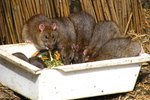
Gray squirrels grip bark with their claws as they leap through the trees performing feats of agility. Their climbing ability helps them seek food, evade predators and mate. These tree-dwelling acrobats leap and run at speeds reaching 10 to 15 mph, according to the State University of New York College of Environmental Science and Forestry website. Secure footing in the trees helps keep them safe. Their claws help them survive in their environment in other ways, as well.
Tooth and Claw
Just as the gray squirrel's teeth enable him to break hard-shelled nuts, his tough, curved claws serve as tools in his daily life. His strong back legs give him powerful leaping ability so he can spring from branch to branch or jump out of reach of a predator. His back feet have five toes and his front paws have four fingers. His thumb-like big toes have nails instead of claws.He builds nests in trees or uses a tree hollow for his home, so he has adapted to be a skilled tree-climber.
Climbing Tools
A close look at gray squirrel claws shows you a powerful curve with a sharp tip. These help the squirrel climb, just as a person might use pitons or a grappling hook and a rope to get a grip on his terrain. The gray squirrel comes equipped to race up a tree and maneuver in any position. He can cling tight to tree bark while traveling up or down. He can reverse his hind foot 180 degrees for maximum agility. When he descends from his nest, he turns his hind feet all the way around to keep his claws hooked in the bark as he climbs face-first down the trunk.
Grabbing Tools
The gray squirrels claws give him a secure grip when he grabs for a branch when leaping from branch to branch. The sharp claws get a hold on the bark helping him jump fast and far safely. The big toe is thumb-like, giving the squirrel and opposable grip. His front claws can grip nuts and dig for his winter cache of food.
Defensive Weapons & Hunting
When attacked the squirrel can use her claws to fight back. The powerful claws may make a predator back off, allowing the squirrel to escape with her life. She also can go on the offensive and use her claws to attack prey. Gray squirrels are omnivores, and while nuts, seeds, fungus and fruit in season are mainstays in their diet, they also eat meat. A gray squirrel will catch insects, frogs and baby birds for food.
References
Resources
Photo Credits
-
Jupiterimages/Photos.com/Getty Images
Writer Bio
Gryphon Adams began publishing in 1985. He contributed to the "San Francisco Chronicle" and "Dark Voices." Adams writes about a variety of topics, including teaching, floral design, landscaping and home furnishings. Adams is a certified health educator and a massage practitioner. He received his Master of Fine Arts at San Francisco State University.




